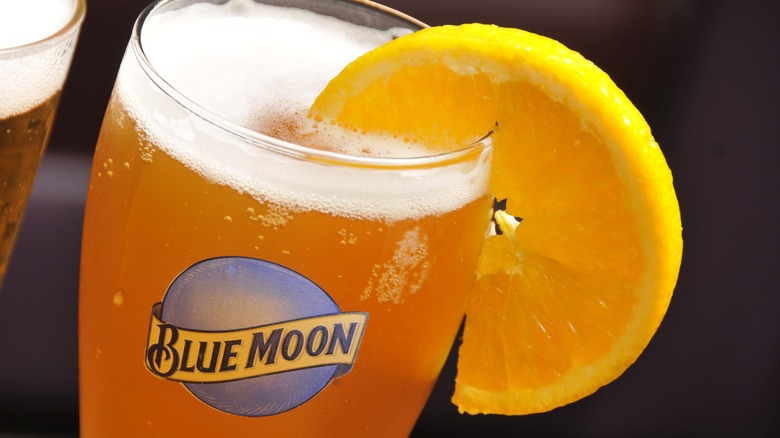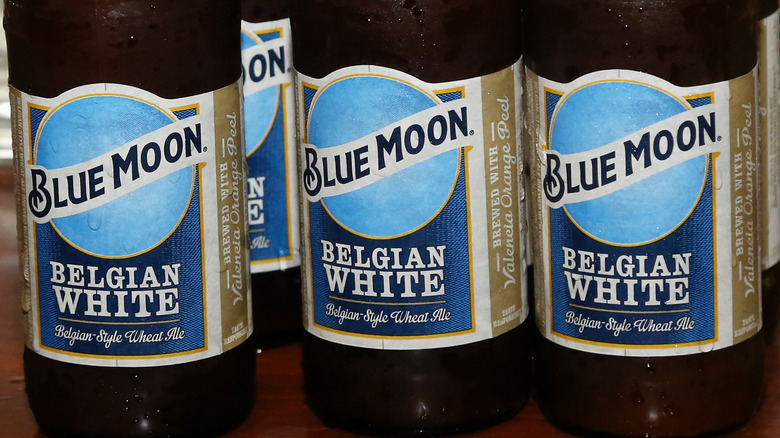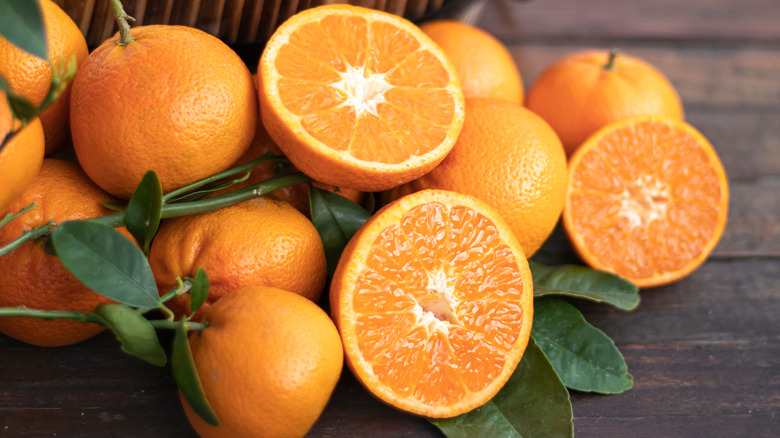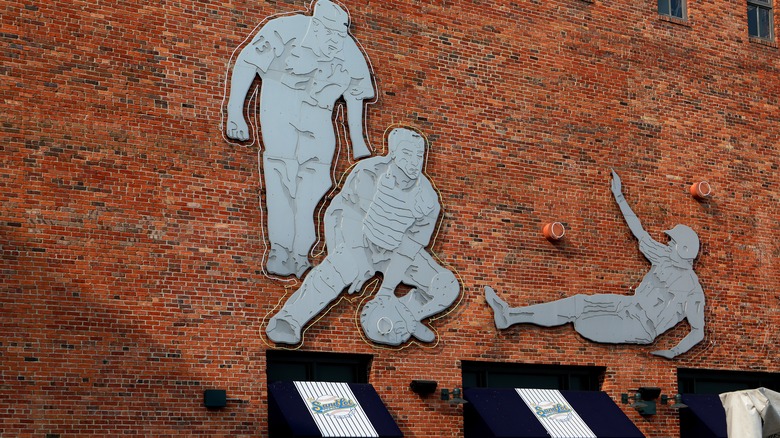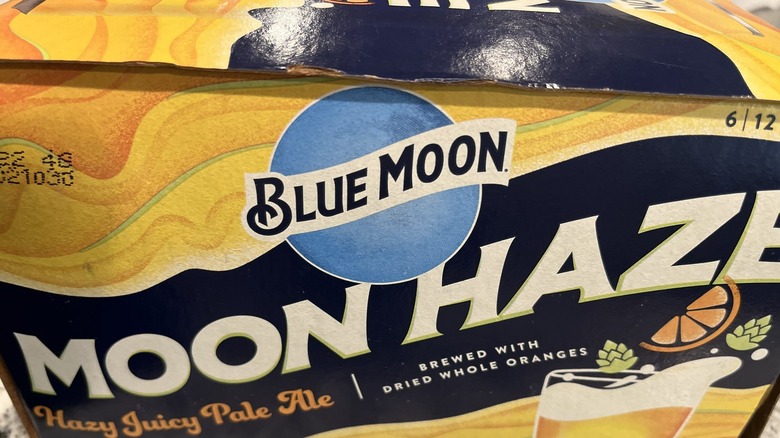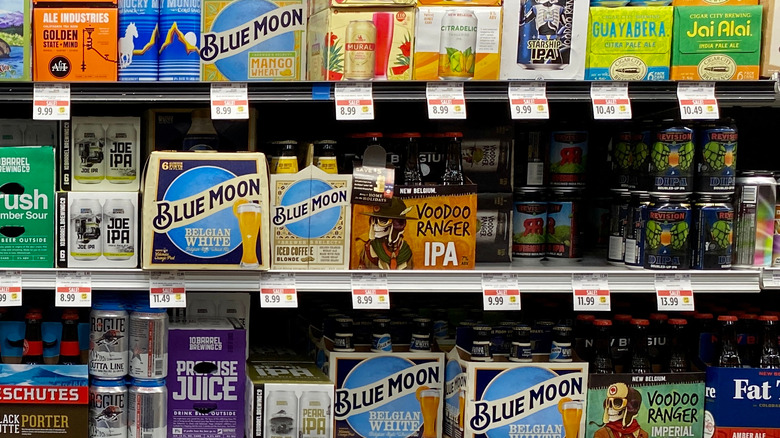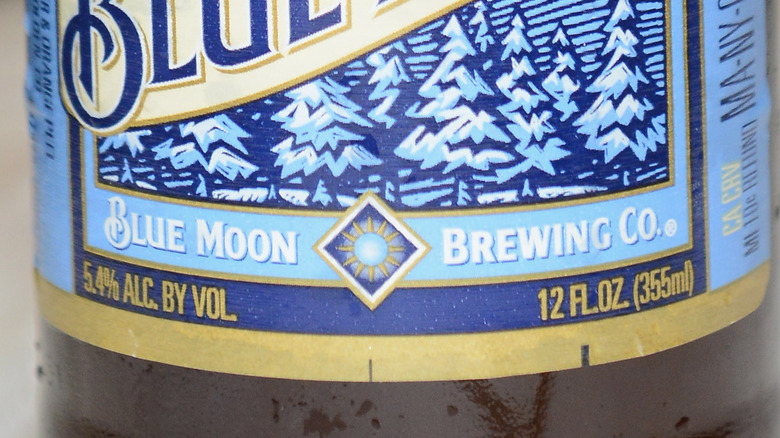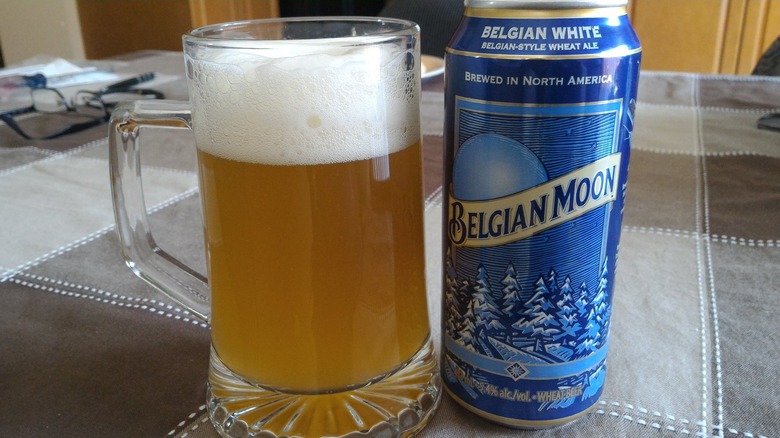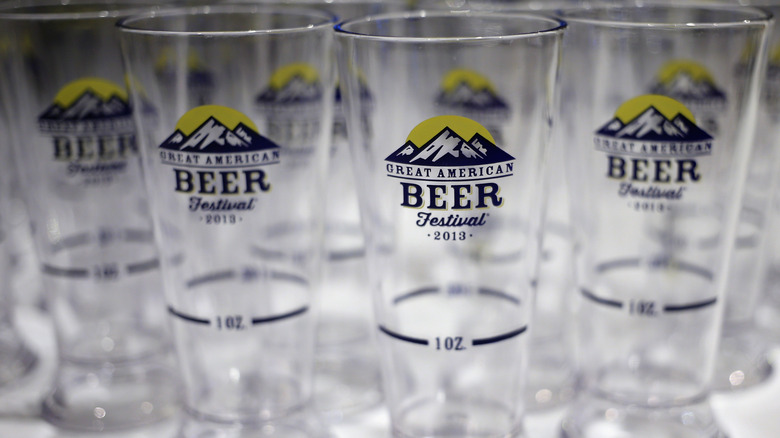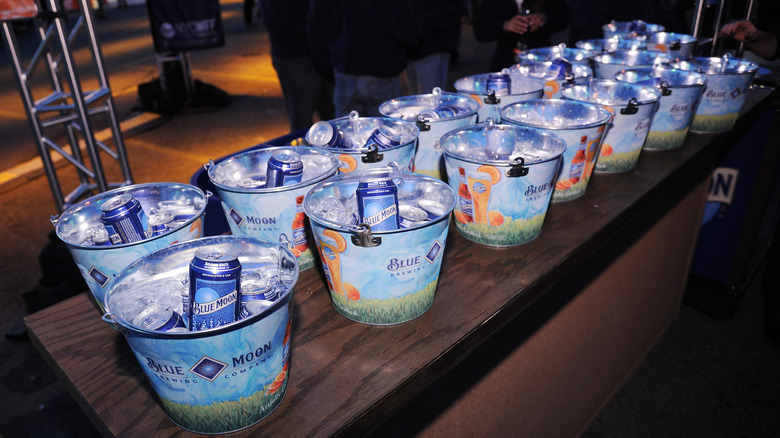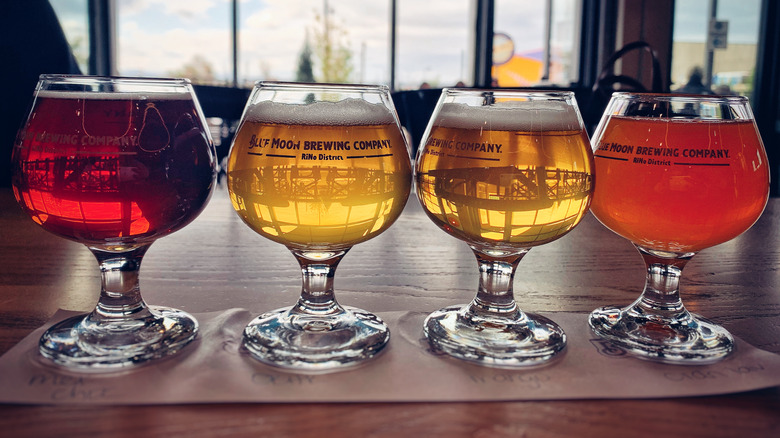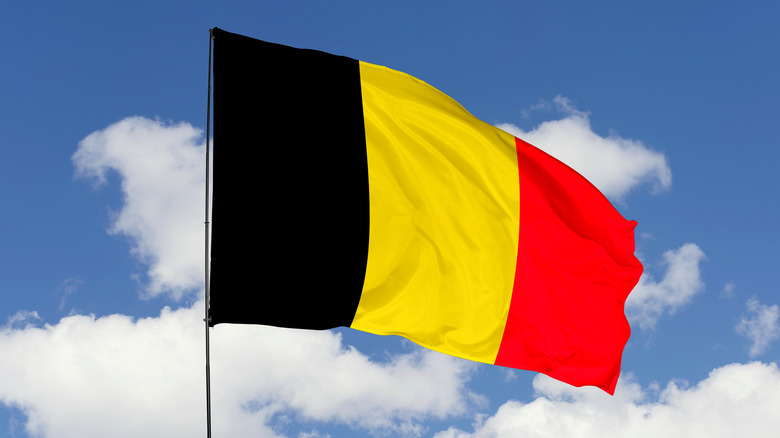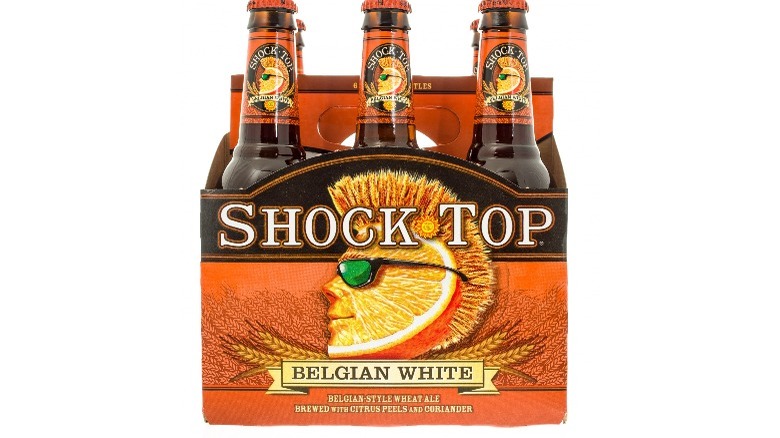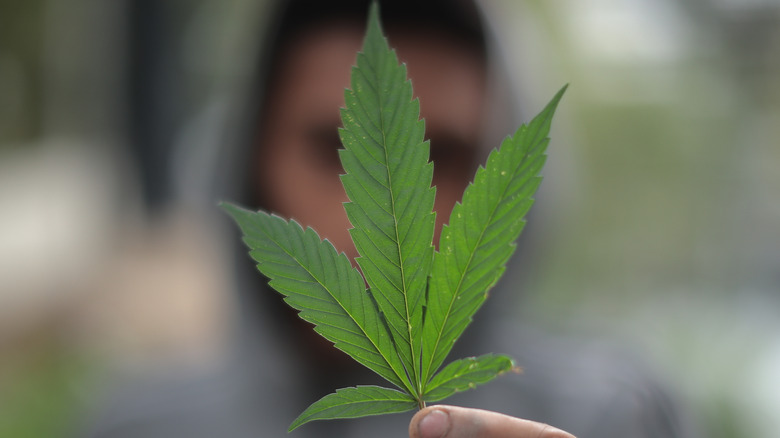Blue Moon: Everything You Need To Know
What makes a beer popular? Nailing down the specific parameters can be tricky. Is it a simple measure of overall sales or the number of markets in which it's sold? Perhaps some more subjective assessments should be considered, like the level of enthusiasm or loyalty displayed by its customer base. Whatever your preferred scale of measurement, some beers are clearly extremely popular, like the light and refreshing classic Blue Moon.
Blue Moon is a monumentally well-known and widely sought-after brand that has easily etched itself into the annals of U.S. brewing history. It was first brewed in 1995 at the Sandlot Brewery in Denver, Colorado (via Blue Moon). This beer can be found and purchased (in-person or online) in virtually every corner of the U.S. as of 2022.
Frankly, it's impossible to envision the modern craft beer landscape without Blue Moon's emergence in the mid-1990s. While some believe its status as a subsidiary of Molson Coors taints its craft brewing claims, the high-brow snobbery of certain craft beer fanatics hasn't dimmed the public's overall appreciation for Blue Moon.
When you're standing alone without a dream in your heart, Blue Moon will almost certainly be there for you. Of course, even its most ardent fan may be unaware of the brewery's wholly unique and distinguished history or many details about the beer itself. There are so many fascinating details to know about this iconic beer.
Blue Moon is a Belgian-style wheat ale
Most beer drinkers are likely familiar with the general flavor profile of Blue Moon Belgian White; the light-bodied, refreshing, citrusy taste found in every sip is instantly recognizable, after all. Of course, the classic, flagship beer sold by the brewery isn't literally a Blue Moon style beer (since that doesn't exist), but rather a Belgian-style wheat ale (via Blue Moon).
For the unfamiliar (including those who've mindlessly read the label in the past without thinking deeper on the name), a Belgian-style wheat ale is a light-tasting, pale-colored beer brewed from unmalted wheat (via CraftBeer.com). In fact, wheat makes up roughly half the grain used in its production, both earning this beer its name, and distinguishing it from other beer styles. As a result, Belgian-style wheat ales don't have an overwhelmingly hoppy flavor profile, and tend to be far less bitter-tasting than other beer varieties.
Blue Moon doesn't use the Belgian-derived term "witbier" to describe its Belgian-style product. But it does use orange peels and coriander as complementary ingredients to enhance the beer's flavor, which, according to both CraftBeer.com and BeerAdvocate, are the two ingredients most commonly used to spice Belgian-style wheat ales.
Oranges are integral to brewing and drinking Blue Moon
While we can certainly understand the aesthetic appeal, we're often a bit underwhelmed by beverage garnishes. Frankly, unless there's a bonafide need for the garnish to exist (like salt on the rim of a Margarita glass) it often just makes enjoying a drink more difficult. In that vein, it's good to know there's an actual, genuine reason why Blue Moon is consistently served with an orange wheel garnish: It complements the beer's citrus flavor and scent, which results from the use of actual orange peels in the brewing process (via Blue Moon).
Now, the fact that Blue Moon uses real orange products in its brewing process may not be news after it has been on the market for almost 30 years. After all, the website clearly acknowledges that Valencia orange peels are a prominent ingredient in the beer's production. But when Blue Moon was first sold to bars back in 1995, many bartenders took a "potato, potato" approach to the beer's citrus flavor, and used a lemon slice rather than an orange when serving the then-new Belgian-style wheat ale.
However, the people at the company were not satisfied with this outcome. So, the brand made an effort to communicate how imperative it felt the use of real oranges (rather than lemons) was to properly enjoying Blue Moon beer. Soon enough, the world heeded the advice, and began utilizing the proper corresponding citrus garnish when serving Blue Moon.
It was first brewed in a baseball stadium
Most beers aren't born in fancy quarters. In fact, many eventually-enormous breweries begin the march to success in an extraordinarily humble setting: Jim Koch started off by brewing Samuel Adams Boston Lager in his kitchen upon starting Boston Beer Company. Of course, we're not entirely sure we'd be able to classify the original brewery responsible for Blue Moon as humble since the beer was actually first created at a brewery inside a major league baseball stadium (via Blue Moon).
To be more specific, the Sandlot Brewery is located inside Coors Field (home of the Colorado Rockies) in Denver, Colorado. According to its website, the Sandlot was the first brewery ever opened inside a stadium, and it serves several baseball-themed beers to Rockies season ticket holders during games.
The precursor for the Blue Moon we know and love was the Belly Slide Wit (still served by the Sandlot as of 2021), though if you're wondering why that brand of beer isn't sold in stores and bars around the country, there's a good reason.
According to Blue Moon, when the original Belly Slide Wit became popular with fans, someone made an off-hand comment, saying that such a delicious beer only appears once in a blue moon. The name struck a nerve with the brewery, and since then, consumers and the world have never again been the same again.
There's more to Blue Moon than just its classic ale
When you say the name "Blue Moon," many are apt to picture Belgian White beer alone rather than an entire brewery. If we were George Washington and could not tell a lie (allegedly) we'd have to admit that we, too, tend to think of Blue Moon as nothing but its Belgian-style wheat ale. But contrary to (what we presume is) popular belief, the idea that Blue Moon is the purveyor of one singular beer product is grossly misinformed. In fact, as of 2022, the Blue Moon brewery offers a variety of different beer flavors (via Blue Moon).
Beyond the classic Blue Moon Belgian White, the brewery also sells a pair of low-calorie beers under the LightSky label: Tropical Wheat (brewed with pineapple) and Citrus Wheat (brewed with tangerine peels). Blue Moon also sells a Mango Wheat beer as well as the Moon Haze, which is the gold-medal winner for juicy/hazy IPAs at the 2020 Great American Beer Festival.
Additionally, according to its website, Blue Moon has produced dozens of now-retired beers since bursting onto the scene in 1995. In other words, Blue Moon hasn't just recently decided to expand its product line; it's been creating numerous different beers since the very beginning.
It's sold across the U.S. and in multiple different countries
When we say that Blue Moon is one of the most popular and financially successful beer brands produced in the U.S., we're not just throwing around high praise for the heck of it. Blue Moon raked in more than $370 million dollars in sales in 2021: More than any other craft beer brand, according to Statista. And, as of 2022, the beer brand isn't just available across the U.S. but in more than 25 countries worldwide, as well (via Blue Moon).
Of course, like many aspects of life, there's more to the story of Blue Moon's wide distribution network than may appear. Sure, Blue Moon is undeniably beloved by both domestic and international consumers alike and it has more than earned its share of the market.
But unlike a small, independent brewer trying to scratch and claw its way into relevance, Blue Moon has an inherent advantage: It's owned by Molson Coors. Still, being owned by the international beer corporation doesn't discredit the beer's accomplishments or negate the fact that it wouldn't be so widely available without a strong customer demand.
There may be no true consensus surrounding the definition of popular, as we alluded to at the beginning. But no matter the defining characteristics, Blue Moon undoubtedly checks off all those boxes.
Until recently, you couldn't buy it in grocery stores in some states
Blue Moon isn't technically a light beer, but it's certainly on the lighter side. We wouldn't necessarily compare its alcohol by volume (ABV) content to a session beer, but its respectable 5.4 percent ABV makes it a reasonable choice for a person eager to enjoy a couple of laidback rounds.
Of course, while you can enjoy a Blue Moon in Minnesota, you won't be able to purchase one with 5.4% ABV at grocery and convenience stores. Because, as of March 2022, it was still illegal for grocery stores inside the state to sell beer with an ABV higher than 4.0 percent (via MinnPost).
It may be unfathomable to residents of most U.S. states, but Minnesota isn't the only one with a legal ABV beer cap for grocery stores, or, at least, it wasn't before the past few years. According to Colorado Public Radio, Colorado and Kansas removed their beer ABV limits of 4.0% in early 2019, several months after Oklahoma did the same.
Utah followed suit soon after, although the ABV was only raised to 5.0% in November 2019, so consumers still weren't able to purchase a Blue Moon in Utah in the way that the brewers intended (via Utah.com).
It was originally sold in Canada as 'Belgian Moon'
Sometimes, when a well-known brand is sold in a different country, it is legally restricted from operating under the same name. Consider how "The Great British Bake Off" becomes the "The Great British Baking Show" when it crosses the Atlantic from Britain to the U.S. (thanks a lot, Pillsbury).
Name changes aren't always motivated by potential legal issues. When Blue Moon was introduced to Canada, it was sold under the brand name "Belgian Moon" for its first six years on the market (via Blue Moon Canada).
Unsure of whether the average Canadian beer drinker would respond to the name Blue Moon without further understanding of the product, the company decided to leave no doubt. By calling itself Belgian Moon, after all, it called attention to the Belgian-style beer being sold.
Additionally, as a Molson Coors spokesperson told VinePair in 2018, the company wanted to distinguish itself from other beer brands sold in Canada, such as Labatt Blue. Hence, the decision was made to ditch the original name when it was first sold north of the U.S. border.
As of 2021, the brewery felt confident it had established its mark in Canada, according to its website. And it finally dropped the Belgian substitute that year, opting for its original Blue Moon moniker.
Blue Moon has won numerous awards
Perhaps some of the animosity felt by some in the craft brewing industry towards Blue Moon, springing from its position as a corporate-owned (rather than independent) brewery, is a simple matter of jealousy.
After all, Blue Moon does have a history of beating its competitors. In fact, not unlike the numerous awards won by Cabot Creamery, Blue Moon's trophy cases are overflowing: The beer's original brewery, Sandlot Brewery, has won more than 45 beer and brewing awards since 1995.
Blue Moon has won awards both big and small. It won the Great American Beer Festival (GABF) award for the best large brewing company of the year in 2010 (via Denver Business Journal). Additionally, it earned a gold medal for Fruit Wheat Beer at the 2016 World Beer Cup.
The brewery continues to put forth prize-winning beer as of 2020, as well, having won a gold medal from the GABF that year for best hazy/juicy IPA with its Moon Haze, according to Molson Coors.
No one can say what the future holds, of course. But considering how well Blue Moon has fared in the past, you can rest easy knowing you've backed a winner with this one.
It's one of the best-selling beer brands in the U.S.
If you follow the lead of the Brewers Association regarding craft beer designation in the U.S., you may not believe Blue Moon is a well-regarded craft brewery because it doesn't qualify as a craft brewery at all. Now, whether or not Blue Moon should be classified as a craft brewery is up for debate, given its lack of independent ownership (hold that thought). But there's no doubt the brewery categorizes itself as a craft brewery, and, according to Blue Moon, it was the best-selling craft brewery in the U.S. in 2021.
You don't have to take Blue Moon's word on that claim alone, though, as it was the best-selling craft brewery in the U.S. in 2021, according to Statista, as well. According to American Craft Beer, Blue Moon is not in condenses with the definition put forth by the Brewers Association. However, it remains one of the most popular beers around.
Additionally, in 2020, Blue Moon was responsible for producing two of the top four growth brands among all craft beers, leaving little room for debate surrounding its stature in the industry (via Molson Coors).
There's no consensus on whether Blue Moon is a craft brewery
What makes a brewery worthy of being designated a craft brewery? There's no shortage of opinions on the matter and no real industry-wide agreement on which beers should or shouldn't be labeled craft.
Blue Moon itself would have you believe it's a craft brewery (and the best-selling one in the U.S. in 2021, at that). But the Brewers Association definition plainly states a brewery owned by a large corporation does not meet the criteria for a craft brewery.
Frankly, it's hard to say which side is right. We can see how some smaller breweries may take offense to Blue Moon's craft beer inclusion, particularly those lacking the production resources and distribution network offered by Molson Coors. But if you set aside the size component when discussing craft brewing and focus on the spirit of innovation and creativity, instead, then Blue Moon seems to fit the bill.
Wherever you stand on the matter, it's clear Blue Moon isn't letting others define its brewery status (via American Craft Beer). It appears eager to continue growing its identity beyond its massively popular Belgian White, having developed a low-calorie beer line, LightSky, in recent years, as well as its award-winning Moon Haze hazy IPA.
Blue Moon was sued over its craft beer designation
We adore craft beer here at Mashed, yet even we can admit that some folks take the entire idea of craft beer far too seriously. Now, we don't mean to diminish any brewmasters or beer artisans who hone their (literal) craft in the industry.
But all things considered, it seems the importance of whether or not a brewery is labeled "craft" is incredibly overblown at times. Case in point: The lawsuit brought against Molson Coors in 2015 alleging the company deliberately misled consumers by falsely portraying Blue Moon as a craft brewery in advertisements (via Consumerist).
Though the plaintiff, Evan Parent, accused Blue Moon of misrepresenting itself based on the Brewers Association's definition of a craft brewery, the bottom line is that no legal definition or industry-wide consensus actually exists for what can (or cannot) be called a craft brewery. Given this, Molson Coors retorted that there was no way to say it had misrepresented itself since no one can say for certain what is or is not a craft brewery (via Consumerist).
The U.S. district judge assigned to the lawsuit, Gonzalo Curiel, agreed with Molson Coors' argument (via Reuters). In June 2016, the case was dismissed, with Curiel writing in his decision that a reasonable consumer couldn't really depend on every aspect of Blue Moon's marketing in its advertisements.
Some Belgian brewers believed the name 'Belgian White' was misleading
Did you ever wonder why Blue Moon's signature beer is described as a Belgian-style wheat ale as opposed to a Belgian wheat ale? It's simple, actually: It's not a Belgian beer because it isn't brewed in Belgium. While Blue Moon is upfront about this fact: It is described as a Belgian-style beer on the label, after all.
Some Belgian nationals didn't think the distinction was initially clear enough (via Denver Business Journal). So, in 1999, a group of Belgian brewers sued Coors, believing it deliberately misled consumers by portraying it as being brewed in Belgium.
A lawyer representing the group, Bart Lazar, said when filing the lawsuit (via DenverPost.com) that "a Belgian-style beer" could be created without misleading consumers. Coors contended it had done nothing wrong, of course, noting the use of the phrase "Belgian-style" on the label, which also clearly stated the beer was brewed in the U.S., not Belgium.
A settlement was reached between the parties, and Blue Moon agreed to make some changes to the label. Luckily, Blue Moon still chugging along more than two decades later.
Shock Top was introduced as a direct competitor in 2006
The rivalry between Anheuser Busch and Molson Coors isn't as acrimonious as, say, the one between Wile E. Coyote and the Road Runner. But that doesn't mean the two titans of the international beer industry aren't constantly looking for ways to one-up the other.
Consequently, few people would likely be shocked (no pun intended) to learn that Shock Top beer, a Belgian-style wheat ale and one of the chief competitors to Blue Moon in the U.S., was actually created by Anheuser Busch in 2006 in hopes of aping some of Blue Moon's customer base (via Quartz).
Though Shock Top was introduced (at least in part) with the goal of overtaking Blue Moon, it's hard to say Anheuser Busch has been successful in that endeavor. To be sure, Shock Top is a worthy counterpart to Blue Moon on the nationwide beer landscape. And, at times, Shock Top appears capable of winning individual battles, like the subjective win it was bestowed by Forbes in 2016 for airing a superior Super Bowl commercial to Blue Moon.
But with Shock Top sales consistently seeming to struggle throughout the 2010s (via Molson Coors), it may just have to settle for being the Pepsi to Blue Moon's Coke. There's nothing wrong with that, of course, but just as there's only one Coke, there's only one Blue Moon.
Creator Keith Villa left to form a cannabis-based brewery in 2018
Considering the almost incomprehensible fact that Blue Moon was first created at a brewery within a baseball stadium, there's little reason to question the creative credentials of the original brewmaster, Keith Villa.
Additionally, as a resident of Colorado, one of the first two states to legalize recreational marijuana use in the U.S. (via ABC News), it's easy to believe Villa would eventually decide to turn his attention toward cannabis-infused beers rather than alcoholic ones.
And, in 2018, he did just that, leaving Blue Moon after 32 years to found CERIA Brewing Company (via Brewbound). When announcing his intention to start CERIA in March 2018, Villa told The Cannabist he'd witnessed the fact that people were not drinking as much beer, which led him to develop alternatives to beer.
According to CERIA, the brewery produces alcohol-free beers through a new brewing process developed by Villa, who, the website notes, has a Ph.D. in brewing sciences. We're not sure whether a cannabis-infused beer sounds more appealing than a standard alcohol-infused one (so to speak). But considering the track record left by Villa, both before and after his time at Blue Moon, who would be foolish enough to doubt the quality?
